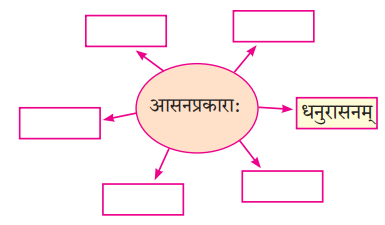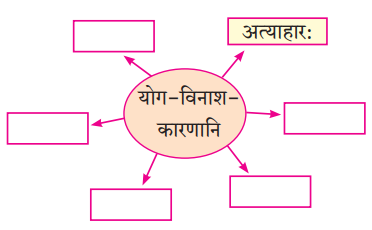भाषाभ्यासः
1. माध्यमभाषया उत्तरत।
अ. शवासनं कथं हितकरं भवति?
उत्तरम् : ‘योगमाला’ या पाठात हठयोगप्रदीपिका या ग्रंथातून श्लोक संपादित केले आहेत. या पद्यामध्ये योगासने व त्यांचे फायदे यासंबंधी चर्चा आली आहे.
योगासनांमुळे शरीर तसेच मनाचे आरोग्य उत्तम राहते. योगसाधना करताना सर्व आसने झाल्यानंतर शवासन केले जाते. ‘या आसनात जमिनीवर पाठ टेकवून शवाप्रमाणे झोपावे अशी कृती केली जाते. शवासनामुळे शरीराचा थकवा दूर होतो तसेच मनाला शांतता मिळते. योगसाधना करताना शरीराला व्यायाम होतो. हा व्यायाम झाल्यानंतर शरीराला आराम मिळण्यासाठी शवासन आवश्यक असते.
‘योगमाला’ a collection of verses from the हठयोगप्रदीपिका composed in the fifteen century by Shri Swatvaram Yogi provides us with instructions for performing asanas and also describes their benefits.
After performing the regular asanas one shouldend the yogasadhana by ‘शवासनम्’. In shavasana one should lie still on the floor like a corpse (dead body). Shavasana takes away fatigue. By performing Shavasana the mind gets relaxed. Shavasana improves concentration and provides peace and rest to body as well as mind.
आ. मत्स्येन्द्रासनस्य कृतिं वर्णयत ।
उत्तरम् :
योगमाला या पद्यपाठामध्ये योगसाधनेचे फायदे व योगसनांच्या कृती सांगितल्या आहेत. उजवा पाय डाव्या पायाच्या मांडीखाली ठेवावा. डावा पाय उजव्या गुडघ्याला बाहेरून वेढा घालून जमिनीवर ठेवावा, तो पाय धरून मान डाव्या बाजूला फिरवून शरीराला पीळ द्यावा. ही मत्स्येनाथोदितमासनाची कृती होय.
‘योगमाला’ a collection of verses from हठयोगप्रदीपिका by Shri Swatvaram Yogi – describes certain asanas and speak of their benefits. While performing मत्स्य नाथोदितासन one should place the right leg at the base of the left leg and should place the left leg covering the outer part of the right knee. Then he should hold the left foot with right hand and twist the body behind. This is ‘मत्स्यनाथोदितासन’.
इ. पद्मासनस्य वर्णनं कथं कृतम्?
उत्तरम् : ‘योगमाला’ या पद्यपाठात विविध योगासनांच्या कृती व त्यांचे फायदे दिले आहेत. पद्मासन करताना उजवा पाय डाव्या मांडीवर ठेवावा. डावा पाय उजव्या पायावर ठेवावा.
मागून उजव्या हाताने झव्या पायाचा अंगठा पकडावा व डाव्या बताने उजव्या पायाचा अंगठा पकडावा. हनुवटी छातीवर ठेवून नाकाच्या शेंड्याकडे एकटक पहावे. पद्मासनामुळे व्याधींचा विनाश होतो. पद्मासन हे योगसाधनेतील अनिवार्य आसन आहे.
In the ‘योगमाला’ the description of asanas as well as their benefits to body and mind are discussed. पद्मासन is the most essential and basic asana. While performing WT one should place the right leg on the left thigh and the left leg on the right thigh.
Then one should hold the toes of the leg by crossing the hands at the back. After attaining a such position, one should keep his chin on chest and should look at the tip of the nose. This complete position is called as पद्मासन. Being very important and a basic asana पद्मासन has to be performed regularly.
ई. योगासनै: के लाभा: भवन्ति?
उत्तरम् :
‘योगमाला’ या पद्यामध्ये हठयोगप्रदीपिका या स्वात्माराम योगी रचित ग्रंथामधून श्लोक संपादित केले आहेत. योगसाधने मुळे शारीरिक तसेच मानसिक आरोग्य उत्तम राहते. योगसाधनेत अनिवार्य असणारे पद्मासन हे रोगनाशक आहे. योगसाधनेच्या शेवटी केल्या जाणाऱ्या शवासनामुळे शरीराचा चकवा तर दूर होतोच शिवाय मनाला शांतता मिळते.
योगसनांमुळे संपूर्ण शरीराचा व्यायाम होतो व शरीर लवचिक व सुदृढ बनते. योगासनांमुळे मानसिक आरोग्यसुद्धा सुधारते. मनाची एकाग्रता आणि स्मरणशक्ती सुद्धा योगासनांमुळे वाढते. योगसाधना ही केवळ शरीरासाठी नव्हे तर मनासाठी सुद्धा लाभदायक आहे.
In the lesson ‘योगमाला’ a collection of verses from हठयोगप्रदीपिका the procedure for performing different asanas, their postures and benefits are discussed.
Doing yoga every day, helps us to be physically as well as mentally healthy. The basic and foremost asana destroys our diseases. Performing yarn at the end of all the asanas relaxes our body and provides peace to our body and mind.
Yogasanas contribute to our physical health and equally to our mental health. One can experience peace of mind, improvement in concentration and memory by doing yogasanas. Yogasanas also help in gaining physical flexibility and helps keep the body light.
2. जलचित्रं पूरयत।
प्रश्न 1.
उत्तरम् :
प्रश्न 2.
उत्तरम् :
3. चित्राणि दृष्ट्वा आसननामानि अन्विष्यत लिखत च।







Leave a Reply